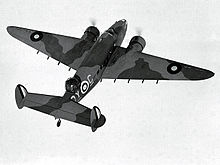
Summary
No. 11 Squadron RCAF was a Royal Canadian Air Force squadron active during the Second World War. It was primarily used in an anti-submarine role and was based on the east coast of Canada and Newfoundland. It was initially formed at RCAF Station Ottawa before moving to Dartmouth, Nova Scotia on 3 November 1939, where it became operational.
| No. 11 Squadron RCAF | |
|---|---|
 No. 11 Squadron Lockheed Hudson | |
| Active | 3 Oct 1939 - 15 Sept 1945[1] |
| Country | |
| Branch | |
| Role | Bomber Reconnaissance |
| Part of | RCAF No.3 Training Command, Eastern Air Command, Western Air Command |
| Nickname(s) | The Joe Squadron[1] |
| Engagements | Second World War |
| Decorations | 8 DFC's, 1 AFC, 1 DFM and 6 MiDs[1] |
| Battle honours | North-West Atlantic 1939-1945 Pacific Coast 1945[2] |
| Flying hours | 25,386 operational, 13,377 non-operational[1] |
| Insignia | |
| Unit Codes | OY (1939-1942) KL (1942)[1] |
| Aircraft flown | |
| Patrol | Lockheed Hudson I & III Consolidated Liberator III, V & VI |
From 26 October 1943 to 17 June 1944, it operated from Torbay, Newfoundland before returning to Halifax for a year, before again moving across the country to Patricia Bay, British Columbia on 31 May 1945.[1] The squadron flew the Lockheed Hudson and Consolidated Liberator maritime patrol bombers before disbanding on 15 September.[3] The unit's first operational flight, on 10 November 1939, was to provide sighting practice for the anti-aircraft guns of the Royal Navy battlecruiser HMS Repulse and aircraft carrier HMS Furious, as well as for the Halifax, Nova Scotia shore batteries.[1]
References edit
Citations edit
Bibliography edit
- Kostenuk, S.; Griffin, J. (1977). RCAF Squadron Histories and Aircraft: 1924–1968. Toronto, ON: Samuel Stevens, Hakkert & Co. p. 33. ISBN 978-0888665775.


